![]()
![]()
![]()
![]()
![]()
![]()
![]()
![]() Though ubiquitous, this is one of my personal favourites. It’s a particularly delicate damsel but it’s the glittering array of five female colour forms that adds to the fascination and, I might say, complication.
Though ubiquitous, this is one of my personal favourites. It’s a particularly delicate damsel but it’s the glittering array of five female colour forms that adds to the fascination and, I might say, complication.
The Female Forms
Of the five female colour forms, two are immature and three are mature. As if the confusion of having various colour forms weren’t enough, we now have naming confusion thrown into the mix.
- The “traditional” names assigned to the five female colour forms have been modified such that one form, originally known as infuscans-obsoleta, is now referred to as rufescens -obsoleta. (This makes much more sense because it is the mature form of rufescens.)
- These traditional names were apparently not good enough for Klaas-Douwe B. Dijkstra who, in his otherwise excellent reference work, saw fit to assign them different names (and rather boring names that are difficult to remember, IMHO).
Here is my attempt at making sense of the resultant naming mess:
| Traditional | (formerly) | Dijkstra |
|---|---|---|
| violacea | A-type immature | |
| typica | A-type mature | |
| infuscans | B-type mature | |
| rufescens | C-type immature | |
| rufescens-obsoleta | infuscans-obsoleta | C-type mature |
 Since a picture speaks a thousand words, here is a diagram trying to clarify the colours and development process. Some folks confuse the immature male colour form, sporting a turquoise thorax, as being one of the female forms, so I’ve included that, too. Some friends have also recorded a couple of female variations additional to the traditionally documented five named forms, so those are now shoehorned in. [See here for a full explanation.]
Since a picture speaks a thousand words, here is a diagram trying to clarify the colours and development process. Some folks confuse the immature male colour form, sporting a turquoise thorax, as being one of the female forms, so I’ve included that, too. Some friends have also recorded a couple of female variations additional to the traditionally documented five named forms, so those are now shoehorned in. [See here for a full explanation.]
I also have a identification/comparison chart showing the differences between I. elegans and the related I. pumilio (Scarce Blue-tailed Damselfly).
Id Notes
- ♂ – bi-coloured pterostigma
- ♂ – dorsal side of abdomen bronze-black except S8 which is blue
- ♂ – blue side of thorax and antehumeral stripes
- imm. ♂ – green but still with dark dorsal side to abdomen
- ♀ – five colour variations, some being immature versions (see photos)
| male | |||
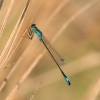 |
 |
 |
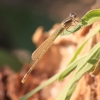 |
| female | |||
 |
 |
 |
 |
 |
|||
| in cop | |||
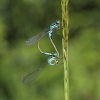 |
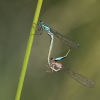 |
 |
 |
| ovipositing | |||
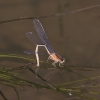 |
|||

[…] https://www.odonata.org.uk/species/ischnura-elegans/ […]